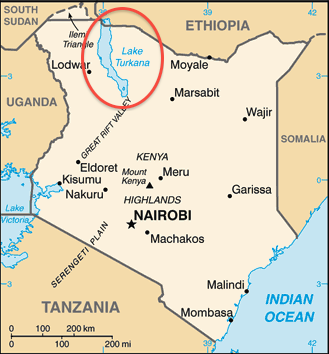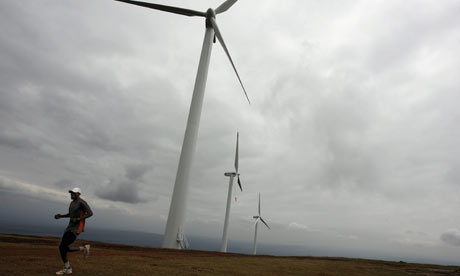The Lake Turkana Wind Power Project (LTWP) aims to provide 300MW of reliable, low cost wind power to the Kenya national grid, equivalent to approximately 20% of the current installed electricity generating capacity.
The Project is of significant strategic benefit to Kenya, and at Ksh75 billion (€582 million) will be the largest single private investment in Kenya’s history.
The wind farm site, covering 40,000 acres (162km2), is located in Loyangalani District, Marsabit West County, in north-eastern Kenya, approximately 50km north of South Horr Township.
The Project will comprise 365 wind turbines (each with a capacity of 850 kW), the associated overhead electric grid collection system and a high voltage substation.
The Vision 2030 Delivery Board will sign a Memorandum of Understanding (MOU) with Lake Turkana Wind Power (LTWP), endorsing the largest single private investment in Kenya’s history, amounting to Sh75 billion.
The project will provide 300 Megawatts (MW) of reliable, low cost wind power to the Kenya national grid, equivalent to approximately 20 percent of the current installed electricity generating capacity.
The wind farm site, covering 40,000 acres is located in Loyangalani District, west of Marsabit County, in north-eastern Kenya and LTWP Chairman Carlo Van Wageningen said that the wind energy resource at Lake Turkana is exceptional.
“The average wind speed is approximately 11 metres per second and wind blows consistently from the South East. Given this exceptional wind resource at the project site, the project will be a reliable and cost effective source of energy for the entire country,” he added.
Van Wageningen noted that in addition to providing reliable low cost power, the project will bring numerous macroeconomic, community and social benefits for the region.
“During the 32 month construction period, up to approximately 2,500 jobs will be created followed by over 200 full time jobs throughout the period of operations, mainly targeting local Kenyans,” he revealed.
“We will be implementing a comprehensive training and international skill transfer program that will not only build capacity for individuals, but also intellectually benefit Kenya as a whole,” he added.
The Government’s Least Cost Development Power Plan shows that LTWP wind power will be one of the least cost power generation options available in the country along with geothermal power and at even less cost than the feed in tariff for other wind projects.
The project will replace the need for Kenya to spend approximately Sh15.6 billion per year on importing fuel.
“This project reduces the need to depend on unreliable hydro and on expensive, unpredictably priced fossil fuel based power generation and insulates Kenya’s power tariff by providing a low and consistent power price,” the Director General of Vision 2030 Delivery Secretariat Mugo Kibati said.
“Kenya stands to save 120 million Euros of fuel imports as a result of shifting its electricity generation mix to include the power to be produced by LTWP,” he added.
The project will comprise 365 wind turbines (each with a capacity of 850 kilowatts), the associated overhead electric grid collection system and a high voltage substation.
The project also includes the upgrading of the existing road from Laisamis to the wind farm site, a distance of approximately 204km, as well as an access road network in and around the site for construction, operations and maintenance.
The Kenya Electricity Transmission Company Ltd (Ketraco), with concessional funding from the Spanish Government, is constructing a double circuit 400 kilovolt, 428 kilometre transmission line to deliver the LTWP electricity along with power from other future plants to the national grid.
Kibati emphasised that Kenya is set to further develop as the hub of trade and logistics in the Sub-Saharan Africa in line with the Vision 2030 outcomes for Kenya.
“The inclusion of a wind farm in Kenya increases the industrialisation efforts for Kenya, which are necessary to helping Kenya realize a middle-income status by 2030 by ensuring that there is access to reliable and cost-effective electricity,” he said.
“In addition, the project will bring numerous social and economic benefits to Kenya, which we as the Vision 2030 Delivery Secretariat are totally committed to implementing,” he added.





